Exploring

Teacher Guide












Constance Beatty Kankakee, IL
La’Shree Branch Highland, IN
Jim M. Brown Saratoga Springs, NY
Mark Case Randleman, NC
Lisa Cephas Philadelphia, PA
Nina Corley Galveston, TX
Samantha Danielli Vienna, VA Shannon Donovan Greene, RI
Michelle Garlick Long Grove, IL
Michelle Gay Daphne, AL
Nancy Gi ord Harwich, MA
Erin Gockel Farmington, NM
Robert Griegoliet Naperville, IL
DaNel Hogan Tucson, AZ
Greg Holman Paradise, CA
Barbara Lazar Albuquerque, NM
Robert Lazar Albuquerque, NM
Leslie Lively Porters Falls, WV
Melissa McDonald Gaithersburg, MD
Paula Miller Philadelphia, PA
Hallie Mills St. Peters, MO
Jennifer MitchellWinterbottom Pottstown, PA
Monette Mottenon Montgomery, AL
Mollie Mukhamedov Port St. Lucie, FL
Cori Nelson Win eld, IL
Don Pruett Jr. Puyallup, WA
Judy Reeves Lake Charles, LA
Libby Robertson Chicago, IL
Amy Schott Raleigh, NC
Tom Spencer Chesapeake, VA
Jennifer Trochez MacLean Los Angeles, CA
Wayne Yonkelowitz Fayetteville, WV
The mission of The NEED Project is to promote an energy conscious and educated society by creating effective networks of students, educators, business, government and community leaders to design and deliver objective, multisided energy education programs.
NEED curriculum is available for reproduction by classroom teachers only. NEED curriculum may only be reproduced for use outside the classroom setting when express written permission is obtained in advance from The NEED Project. Permission for use can be obtained by contacting info@need.org.
In support of NEED, the national Teacher Advisory Board (TAB) is dedicated to developing and promoting standardsbased energy curriculum and training.

NEED believes in providing teachers and students with the most recently reported, available, and accurate energy data. Most statistics and data contained within this guide are derived from the U.S. Energy Information Administration. Data is compiled and updated annually where available. Where annual updates are not available, the most current, complete data year available at the time of updates is accessed and printed in NEED materials. To further research energy data, visit the EIA website at www.eia.gov.
1.800.875.5029 www.NEED.org © 2023
Printed on Recycled Paper
Standards Correlation Information 2
Materials 5
Teacher Guide 6
MHK Resources 21
Rubrics for Assessment 22
MHK Bingo Instructions 23
Forms and Sources of Energy Answer Key 25

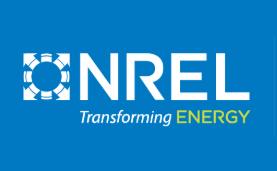

Electric Connections Answer Key 26
Measuring Electricity Master 27
Basic Measurement Values in Electronics Master 28
Measuring Electricity Answer Key 29
Global Ocean Surface Currents Master 30
Magnet Hints and Tips Master 31
MHK Bingo 32
Evaluation form 35
Exploring Marine Hydrokinetics was originally developed by The NEED Project with funding from the National Renewable Energy Laboratory and the U.S. Department of Energy, Water Power Technology Office. NEED would also like to acknowledge Mr. Walter Schurtenberger of Hydrokinetic Energy Corporation and The College of the Florida Keys for his technical advisement and support in the creation of this unit. NEED is grateful to its Teacher Advisory Board team and staff members for designing this unit:
Nina Corley
Shannon Donovan
Robert Griegoliet
Christine Lauer
Paula Miller
Doug Keaton
Tom Spencer
Cover image courtesy of Jules Smoke, IKM Testing UK
www.NEED.org/educators/curriculum-correlations/

This guide effectively supports many Next Generation Science Standards. This material can satisfy performance expectations, science and engineering practices, disciplinary core ideas, and cross cutting concepts within your required curriculum. For more details on these correlations, please visit NEED’s curriculum correlations website.
This guide has been correlated to the Common Core State Standards in both language arts and mathematics. These correlations are broken down by grade level and guide title, and can be downloaded as a spreadsheet from the NEED curriculum correlations website.
This guide has been correlated to each state’s individual science standards. These correlations are broken down by grade level and guide title, and can be downloaded as a spreadsheet from the NEED website.
Electricity, Electromagnetism, and Circuits
9-volt Batteries
Compasses
Motors (1 disassembled, if possible)
Alligator clips
Large nails
LED bulbs
9-volt battery clips
Masking tape
Conductive dough
Energy in Waves Demonstrations
Slinky-style spring
Plastic 1 or 2 liter bottle
Cooking oil
Water
Small plastic cube, brick, or bead
Funnel
Hot glue gun
Food coloring
Making Waves Demo
Transparent tub or box
White paper
Clip lamp with bulb
1” PVC pipe or dowel
Ocean Current Formation
Large, clear container to represent ocean or large body of water; shoebox sized or larger
Thermometers
5mL Transfer pipettes
50 mL Beakers or cups
Red, blue, or green food coloring
Spoons
Table salt
Ice
Hot plate or hot pot
Model Wave Generator
Clear, plastic tubing
Cylindrical magnets, diameter close but not equivalent to the inner diameter of the tubing
Magnet wire
Fishing bobber or floats
Rulers
Permanent markers
Scissors
Galvanometers
Alligator clips
Large 4-5 gallon tub
Hot glue guns and extra glue sticks
1 Spool of fishing line
1 Pool noodle
Waterproof duct tape
Utility knives
Fine-grain sandpaper
Anchors or weights
Secondary, grades 9-12
7-14 class periods depending on the length of class periods and the activities you choose to conduct
The magnets in the Model Wave Generator are very strong. In order to separate them, students should slide/twist them apart. Please also take the following precautions:
Wear safety glasses when handling magnets.
Use caution when handling the magnets. Fingers and other body parts can easily be pinched between two attracting magnets.
When students set the magnets down they should place them far enough away from each other that the magnets won’t snap back together.
When you are finished with the magnets and ready to store them, put a small piece of cardboard between them.
Keep magnets away from your computer screen, cell phone, debit/credit cards, and ID badges.
Do not allow the magnets near a person with a pacemaker or similar medical aid. The magnetic field can affect the operation of these devices.
Moving water in the ocean creates a large amount of kinetic energy. Marine Hydrokinetics (MHK), also known as Marine Renewable Energy (MRE), involves the use of technology to harness this energy from the oceans in order to generate electricity to power our lives. MHK or MRE incorporate power from ocean surface waves, ocean currents, tidal movements, and even the power produced from thermal and salinity differences throughout the waters of the world.
Exploring Marine Hydrokinetics is an exploratory unit for secondary students that includes teacher and student guides containing comprehensive background information on energy, the properties of fluids and waves, electricity, hydrokinetic technologies, and careers in the emerging industry of MHK/MRE. Students will have the opportunity to apply the science of the oceans and electricity generation as they learn about the many types of MHK technology, explore case studies, consider siting a project, and build their own sample wave generator model. The curriculum includes handson, inquiry-based explorations, group presentations, and cooperative learning activities. Many of the materials suggested can be easily gathered from a craft, hobby, or sporting goods store, and are substituted easily with similar materials found in your classroom and beyond.
Energy is found in many forms—potential and kinetic.
Many energy sources are converted into electricity because it is easy to transport and use.
Moving water is a renewable energy source.
The energy of moving water can be harnessed and converted into electricity in many ways, including technologies for harnessing the energy in ocean tides, waves, and currents.
MHK is an emerging industry with great possibility for energy generation and career opportunity in the U.S. and is still being researched widely.
There are many advantages and challenges to deploying MHK technologies, and these advantages and challenges can vary greatly depending on the location, modality, and many other factors.
Throughout this curriculum, science notebooks are referenced. If you currently use science notebooks or journals, you may have your students continue using these. A rubric to guide assessment of student notebooks can be found on page 22 of the Teacher Guide.
In addition to science notebooks, student worksheets have been included in the Student Guide. Depending on your students’ level of independence and familiarity with the scientific process, you may choose to use these worksheets instead of science notebooks. Or, as appropriate, you may want to make copies of worksheets and have your students glue or tape the copies into their notebooks.
Read the Teacher and Student Guides thoroughly and decide how you are going to implement the unit in your classroom.
Preview the list of links on the MHK Resources page to gather any additional information or context that might assist you in implementing the unit.
Obtain the additional materials needed for the hands-on activities using the materials list on page 5.
Make copies or prepare digital copies of any student pages or masters you wish to share.
Become familiar with the hints and tips on page 31 to help students troubleshoot when creating their models.
Students will be able to list basic prior knowledge about energy, oceans, and electricity.
MHK Bingo, page 23-24 and 32 Internet access
1. Navigate to the National Renewable Energy Laboratory’s PRIMRE Portal to explore MHK and get students thinking about its possibilities by touring the REDi Island, https://openei.org/wiki/PRIMRE/REDi_Island.
2. Have students play MHK Bingo as an ice breaker and to gauge their prior knowledge about energy, oceans, electricity, and MHK.
3. Instruct students to make KWL charts in their science notebooks and individually list what they know and would like to know about MHK. Have each student exchange their information with a classmate.
4. Facilitate a class discussion about the role of electricity in modern society and their thoughts on the importance of using new energy technologies in meeting electricity demands. Make note of student misconceptions to address as you work through the unit.
Students will create a presentation and instruct others on topics related to marine and hydrokinetic energy.
Student Informational Text, Student Guide pages 3-24
Forms and Sources of Energy Answer Key, page 25 Electric Connections Answer Key, page 26
1. Divide the class into groups as noted below. Certain topics may be less difficult than others, which may be helpful when differentiating and selecting groups. The topics are related to sections of the student informational text. Depending on your students and their prior knowledge, you may be able to skip some of the topics or create subtopics from some sections to allow the lesson to progress at the desired depth and pace.
Student Topic Groups and Student Guide Pages
Forms and Sources of Energy – Pages 3-4
Electricity – Pages 5-9
Oceans – Pages 10-11
Wave Energy – Pages 12-14
Tidal Energy – Pages 15-16
Ocean Currents and Other MHK – Pages 17-19
Constructing and Siting MHK - Pages 20-21
Careers – Pages 22-23
2. Assign the groups to create five-minute presentations to teach the class the basics of their topics, using the text information in the Student Guide. It is suggested that the students use, at most, one to two class periods to create their presentations. Groups should not go into great amounts of depth on their topic, rather the aim is to help break up the text into a jigsaw-style activity and introduce content in a more interesting way.
3. Choose a specific format for the presentations—such as a PowerPoint, tri-fold boards, or movie—or allow the groups to choose their medium. Provide students with any preferences and parameters for creating and delivering the presentations. Explain how the presentations will occur and give students time to work.
4. As the groups deliver their presentations, make sure the other students are taking notes and adding information to their individual KWL charts or notes.
5. Use the Culminating Project Rubric on page 22 to evaluate the presentations.
6. To ensure students have a proper foundation for energy and energy sources complete the Forms and Sources of Energy activity as a class and discuss the results. Ask students how they think hydropower and other sources might change as the use of hydrokinetics is expanded in the U.S. Answers can be found on page 25; project as needed.
7. Review electricity generation in the U.S. by completing Electric Connections as a class. First ask the students to rank the sources individually, following the prompts on page 25 of the Student Guide. Then ask them to come to group consensus and develop a group ranking. Once this is complete, have them flip to the next page and determine the actual rankings, given the data in the “statistics” column. Have them compare their original personal ranking and group ranking to the actual rankings. Discuss participating in group discussions and how to participate based on error points. Then, discuss the results and ask students again how they see numbers and roles shifting as the use of hydrokinetics is expanded. Answers can be found on page 26; project as needed.
8. Have students revisit their KWL charts, adding or editing information they have learned and still wish to research.
This activity contains two separate hands-on stations to demonstrate electricity and magnetism, and circuitry. These concepts are important to understanding how we generate electricity from moving water. Students can work through one station and complete the next. The activity calls for you to make conductive dough for the circuits station. If you have circuit boards with switches and bulbs, you may use these instead.
Students will be able to describe and assemble series and parallel circuits.
Student Guide handouts, pages 27-28
Station worksheets, Student Guide pages 29-32 NOTE: Conductive dough recipe found at end of activity.
Preview the two activities.
Set up three stations of each activity for a total of six stations. The first three stations should each have 1 battery, 1 battery clip, 1 ball of dough, and a few LEDs. The last three stations should each have 1 battery, 1 set of alligator clips, 1 nail, 1 compass, and a set of motors (2 assembled, 1 disassembled).
Make copies of the handouts for each activity. Place them at the stations as needed, or pass out to students as desired.
1. Explain to the class that electricity, magnetism, and circuitry are a key component of the hydropower industry. Students will be building their own generator model and thinking about transporting electricity in future activities. These hands-on stations will help prepare them for upcoming challenges.
2. Divide students into 6 teams to complete the activities. Explain that three teams will start at each activity. Halfway through class they will switch activities.
3. Give the class a preview of each of the hands-on stations. Go over any important safety information about electricity, batteries, and magnets important for your class. Show students how to assemble the battery clips, review the LEDs (one end is negative, one positive), and explain that the conductive dough is taking the place of wires in the activity.
4. Give students time to complete their first station and direct students to disassemble any components. Switch activities after a desired amount of time has passed.
5. Review the activities as a class and reflect on what students have learned. Ask students to explain or write about their observations of series and parallel circuits. Ask students to explain how electricity and magnetism are related, and how electromagnetism is involved in motors and generators.
6. Introduce or renew electricity measurement and calculations using the Student Guide pages and Teacher Guide masters/keys. These may prove to be helpful for later activities.
Encourage students to explore different sizes of cells (batteries) in the Station 1 activities. How does a 9-volt compare to a 1.5-volt D battery, and then a 1.5-volt AA battery. Take a look at the cells while hooked up to a multimeter, while also looking at compass motion, etc.
For a deeper exploration into how generators work, download the instructions for NEED’s generator model activity, The Science of Electricity. Construct a model generator for the class to explore, or have students work in small groups to create their own. Activity instructions and materials can be viewed at https://shop.need.org/products/science-of-electricity-model
Make conductive dough for use in your circuits activity. The dough has enough resistance for safe use with mini LED bulbs and 9-volt batteries. The dough is fairly easy to make using flour, salt, and acid. If stored in a sealed container properly, the dough will keep for many uses. Regular Play-Doh™ is often a suitable substitute, but may not have the same level of conductivity as this recipe.
1 cup flour, plus extra for kneading
1 cup water
¼ cup salt
9 Tbsp lemon or lime juice
1 Tbsp vegetable oil
Food coloring for fun effect
1. Mix all of the materials together over medium heat. Continue stirring over the heat until it solidifies.
2. After the mixture solidifies, remove from heat. Place the mixture onto a counter or cutting board with flour (approximately ¼ cup) for kneading.
3. Knead the mixture until it feels like common play dough and is no longer sticky.
4. Roll the dough into smaller balls that students can reshape to act like wires.
5. Store in a sealed bag or container for future use. If oil separates, re-knead the dough with more flour.
Marine renewable energy generates electricity in many forms, including waves. Water waves share some basic understandings as any other waveform, including mechanical and electromagnetic waves. In this digital lab, students will work independently or in groups to learn about the tendencies of transverse waves. Understanding how waves move and interact on a small scale informs how they interact on a larger scale.
Students will explore, describe and compare what happens to waves as they change speed.
Students will be able to observe and describe how energy is transformed in wave form.
Internet Access
PHET Simulation: https://phet.colorado.edu/en/simulations/wave-on-a-string
Wave Basics Notes Video: https://youtu.be/UMC1EI-2sLo
Wave Basics Notes, Student Guide page 33
Wave Speed Labs worksheets, Student Guide pages 34-35
Download and/or preview the PHET simulation. Become familiar with how students will manipulate the application during their labs.
Download and/or preview the notes video.
Prepare physical or digital copies of the notes page and worksheets as needed.
1. To establish vocabulary and background knowledge, have students watch and take notes on the Wave Basics video lesson. This will help clarify terms that are connected to waves. These terms will become variables to explore in later labs.
2. Have students complete the Wave Speed Labs, beginning with the amplitude lab. In this experiment they will use the PHET simulation to explore how amplitude and pulse width. After changing a single variable, they will quantifiably measure the speed in cm/s using a digital ruler and timer. All instructions are listed in the procedure section of the Student Guide.
Students will continue their exploration of waves by allowing the waves to interfere with one another. They will analyze the speed and direction of the wave to establish that waves pass through one another, not bounce off one another. All instructions are listed in the procedure section of the student guide.
Students will continue their exploration of waves by allowing the waves to reflect off fixed and loose end barriers. They will analyze the speed and direction of the wave to establish how waves act when reflecting off a barrier.
3. Discuss the results of the labs as a class.
Have students use the simulation to further explore other wave properties. Students can explore the following: tension (wave speed), reflection, and interference. This exploration would be great for making connections to physics and physical science standards, but not all may be applicable to the field of MHK.
As discussed in the digital labs of Activity 3, a wave is a disturbance in some medium that transports energy from one location to another without transporting the matter. These demonstration activities aim to connect the physics of the previous labs to real waves, eventually looking at water, or the ocean, as the medium. The first, simple demonstration involves using a slinky spring. By marking one of the coils of the spring, students will be able to see that the energy is transferred through the coils by vibrations, the coil itself does not move horizontally from its original position. The second demonstration allows students to visualize how waves can be generated and propagated– by the wind. The bottle demonstration will model the effect of wind on the oceans by using a bottle with a back-and-forth motion.
Students will be able to observe and describe how energy is transformed in wave form.
Slinky-style spring
Plastic 1 or 2 liter bottle
Cooking oil
Small plastic cube, brick, or bead
Funnel
Hot glue gun
coloring
Set up the spring for the wave demo so that you have space to move it, but also something onto which you can affix one end.
Set up the “Ocean in a Bottle” as written below, or gather and set-up materials for your students to create their own. Ocean in a Bottle – Construction Instructions

1. Review wave properties with the students and remind them that we can harness the energy within waves. Revisit a few of the examples from the student text as necessary.
2. Demonstrate wave motion for the students using a slinky-style spring. Hold or affix one end to something so that this end does not move. Move the other end up and down with your hand. If you like, tape or mark one of the coils of the spring.
3. Ask students to describe what they notice. Ask them to verbally make connections between this spring and the digital labs. What similarities do they see? How do they think the motion might differ with a different material or medium?
4. Show students the “Ocean in a Bottle” set up. Turn the bottle to the side and gently oscillate back and forth to make waves.
5. Tell students to observe the motion of the plastic cube and ask the class to discuss if work is being done. Ask the class to describe how they know? Explain or review the Work-Energy Theorem to describe what is happening and explain that harnessing energy from the waves will require devices that are able to move with the waves, like they see with their plastic shapes. Explain to the class that you will be exploring wave generators in future activities.
In this demonstration, you will construct a simple wave generator in front of the class. Students can observe the nature of water waves through their shadows. This could be further developed by adding a plastic shape into the water tank and observing the effect of the waves generated in terms of their wavelength, making connections to deep vs. shallow water and wave generators.
Students will be able to observe and describe how energy is transformed in wave form. Students will be able to design or enhance a model to demonstrate the energy transformation in waves and how it can be harnessed.
Transparent plastic box or tub
Overhead or clip lamp with bulb
White paper
1” diameter pipe, dowel, or cylinder (will be used in water, must fit inside box)
1. Place white paper on the surface of a table and position the transparent box on top of the paper.
2. Fill the box half-way with water.
3. Set up a lamp so that it is suspended over the box and the light shines onto the box.
4. Place the pipe or cylindrical object inside the box (in the water). Roll the item back and forth to generate waves.
5. Have students observe the wave shadows by looking down at the paper. If necessary, project a document camera or video of what is happening to ensure all students can observe.
6. Ask students what will happen to the wave characteristics (wavelength) if you make a portion of the tank shallower?
7. Ask the class how they could use what they observe in this model to design a device the captures energy from wave motion in the ocean. Give them time to brainstorm and discuss as a class.
8. Have the class revisit their KWL charts, adding to and revising their notes, now that they have completed the wave activities.
Ocean currents are moving seawater, often acting like giant conveyor belts moving water globally and locally in such a way that affects climate, local ecosystems, and even what we eat. Ocean currents are continuous, predictable, and directional. Currents can be generated and driven by several forces or factors that act upon the water: gravity (tides), wind, and density (based on depth, salinity, and temperature). Winds primarily drive ocean currents in the upper 100 meters of the ocean surface. However, currents are still flowing far below the surface. Deep-ocean currents are driven by density differences, something called thermohaline circulation. Warm, salty water is carried to the polar regions and cooled. The cooler it becomes, the denser the water gets. Sea ice can form as the water cools, but the salt does not form in the ice, and is left behind in the water surrounding the ice, making it even more dense. This dense water sinks, allowing more ocean water to move into its place creating a current. This activity will help students to visualize ocean current dynamics.
Students will be able to explain how temperature affects water density.
Students will be able to explain how salinity affects water density.
Students will be able to explain how density factors into ocean current formation.
Large, clear container to represent ocean or large body of water; shoebox sized or larger Thermometer
Transfer pipette, 5mL 50 mL beaker or small paper or plastic cup
Bottle of red, blue, or green food coloring Spoon
Exploring Ocean Surface Current Formation, Student Guide pages 36-37
Box of table salt Ice
Hot plate or hot pot
Global Ocean Surface Currents Master, page 30
Decide if you will fill containers with water ahead of time so they can equilibrate to room temperature and if you will pre-prepare the saturated salt solution.
Gather materials for each student group to use. Transfer pipettes can be rinsed with distilled water and reused from one class to another rather than thrown away after every class period.
1. Preview the activity for students and identify the location of all materials they will use. If you are modifying the procedure as written, provide those instructions at this point.
2. Allow students enough time to complete the activity.
3. When students have finished, have them return to their seats for discussion of the activity. Students should have observed rising convection when less dense (warm, or fresh into salt) water was injected into the container. Students should have observed falling convection when more dense (cold, or salt into fresh) water was injected into the container.
4. Ask students how this models actual ocean currents. What limitations does this model impose?
5. Project the master, showing the circulating pattern of prevalent ocean currents.
6. Ask students to predict where currents rise and where they fall, citing evidence from the activity. CONTINUED
7. Navigate to https://www.youtube.com/watch?v=CCmTY0PKGDs and show students this NASA animation of ocean currents worldwide. Ask students to predict where currents are warm and where they are cool; where they are rising and where they are falling. Ask students how density relates to global ocean current patterns.
Have students test a variety of conditions, including fresh or salt water in the tanks, and different temperatures of water, to understand how temperature and salinity affect density. Do as many different combinations as time and materials allow.
Give students a drinking straw. Have one student blow gently on the surface of the water, creating “wind”, while the other student releases the colored water from the transfer pipette. Because wind and density are the two most influential factors in ocean current patterns, students will begin to understand how they work together to create the ocean currents we observe on Earth.
In this cooperative learning activity, students work in small groups to prepare short digital presentations on advancements in marine or hydrokinetic energy. Their presentation will highlight an emerging method of generating electricity using the motion of ocean water.
After researching an advancing technology in marine renewable energy, students will create an advertisement for their generator. The advertising or fundraising commercial created by each group will be in competition with other marketing teams.
Students will create a factual, persuasive video presentation that explains and advertises a marine renewable energy generator.
Internet Access
MHK Researcher Organizer, Student Guide page 38
You may consider researching a handful of prepared examples to share with students, but they should have the freedom to choose which generation model they will research. As this field is very diverse and ever-changing, there are many options to choose from. Consult the resources list on page 21, and the student text for some beginning insight.
Students should have internet access and be familiar with the video recording/sharing program of your choice (Flip Grid, Screen Castify, etc.). If necessary, create a list of parameters for recording/sharing in the program you prefer.
1. Introduce students to the activity by explaining that they have been hired to create a marketing video for an emerging ocean energy technology. They will be creating a short (2-4) minute commercial to advertise and raise funds for the generator of their choice.
2. Lead students in a discussion of common keywords that may help them make their search easier. Common examples would be hydrokinetic, marine energy, waves, currents, etc. Encourage students to pull from any previous background knowledge or visit their KWL charts.
3. Break the students into teams or allow them to form their own. In their research team, they must find a design for a generator that transforms the motion of ocean water into electrical energy. Remind students that they are looking for a technology outside of typical hydroelectric dams.
4. As they research, have students use the following guiding questions to improve their focus:
Who designed and produced the generator?
Is it currently in production? When will it be in production?
What form of moving water powers this generator?
How does the generator transform the motion of water into electricity?
What is the generation capacity of this generator (how much power)?
What are the benefits of this generator?
What are the limitations of this generator?
Why do you recommend this generator?
5. Using the information that they have gathered, students will compile the answers to their guiding questions into a video commercial for their generator. The video should be sure to answer as many of the guiding questions as possible.
6. Students should share their video advertisements with the rest of the class to watch and review.
7. Have student peers, yourself, or other staff act as judges as they vote on the marine energy generator that they would invest in. Remind judges to base their judgment on the information presented, but also based on the quality of arguments made and engagement of the commercial. If using Flip Grid, you can have other students watch, respond, and vote on their peers’ commercials in the Flip Grid app.
The process of choosing a location to deploy a marine or hydrokinetic device, known as siting, requires consideration of many factors. Be sure you have reviewed the background information on some of these factors found in the informational text in the Student Guide. In this activity, students will synthesize several maps to isolate important factors that must be considered when selecting a technology type and location.
Students will use data to justify decisions.
Students will use maps to tell a story.
Students will discuss tradeoffs related to the siting of MHK technologies.
Internet/computer access
Site Assessment Challenge worksheet, Student Guide pages 39-40
Prepare physical or digital copies of the worksheet for the students to use. Decide if you will encourage students to work in small groups or individually.
Prepare a map of Hawaii to showcase to the class, digitally or physically.
Preview the state energy information for Hawaii to add to student discussion and help with any questions students may have if from outside of the state, https://www.eia.gov/state/?sid=HI
1. Review and showcase examples of MHK technologies if necessary.
2. Showcase the state of Hawaii to students. Explain that Hawaii will be the focus for this activity, and discuss the activity instructions. Discuss as a class why Hawaii is a good case study for a siting activity. Make a list of information students know and wish to know about Hawaii, its population, its industry, and its energy needs.
3. Tell the class they will work to pinpoint a device type, a location, and make a list of considerations for their development team. Make sure to point how you wish for them to present their findings (discussion, presentation, slide deck, etc.), and how in-depth you require their work to be. Allow students time to work.
4. Have students share their results with the class. Discuss the challenges and advantages of teams who are willing to engage. Lead the class in a discussion about the variables in choices for technology and sites, and any similarities and differences in the class’s work as a whole. Ask the class to make a list of stakeholders who might need to be involved in the siting and deployment of new technology in Hawaii waters.
Gather GIS data and information for other coastal regions and conduct the activity again.
Review careers and real-world connections associated with development projects, proposals, and construction.
Visit https://www.boem.gov/ and discuss the process and time requirements for getting projects approved for use in Federal waters. Ask students how this might further add to the challenges of siting and deploying MHK.
When new technologies or infrastructure are constructed and implemented, there are often many folks in the area of the construction who take an interest in how the technology or infrastructure in question will impact their community. These stakeholder discussions are important to ensure that all viewpoints are considered, and technology or infrastructure is constructed and implemented responsibly. In this cooperative and creative activity, students will review a fictitious article and case study related to the implementation of MHK technology in the Cook Inlet of Alaska. Groups will be assigned to a viewpoint group and conduct research related to the environmental, economic, social, and political issues that might arise from the implementation. The class will participate in a debate-style regulator’s hearing to showcase their research and viewpoints.
Students will be able to describe the advantages and challenges of MHK installations.
Students will be able to consider multiple viewpoints regarding an issue.
Students will be able to engage in argument from evidence.
Internet/computer access
Clock or timer
MHK Case Study and Hearing handouts, Student Guide pages 41-44
Preview the case study/article and the research links on the student pages.
Decide if you will hold the hearing or if you plan to have students submit written arguments in an alternative format such as a blog/ message board, letters, or even video format. If opting to hold an in-person hearing, prepare any additional judges or personnel for the hearing, and prepare your room to set-up for the hearing. Alternatively, if you plan for written submissions, prepare the prompt or submission site you plan to use and make note of any parameters you need to share with the class.
Make copies of the handout for students.
Pre-assign your students to three groups: pro-tidal, anti-tidal, and environmental regulators. The regulators group should be the smallest group with 3-5 students.
1. Read the case study portion aloud or assign it to the class to read for homework. Go over any questions students may have about what they have read.
2. Review the types of issues covered in this debate: Environmental (nature only - not humans), Social (humans - health, culture, aesthetics), Economic (money- profits, jobs), and Political (politics – laws, rights, taxes). Ask students to list some issues they are familiar with elsewhere in life. Does each issue fall under one category entirely, or do some issues require discussion in several categories?
3. Lead students into a discussion on stakeholders. Explain that stakeholders can be anyone who might have an opinion or feel impacted by a decision. Have students make a list of potential stakeholders for THIS case study. Some examples may include: fishing industry, property owners, tourism board, indigenous populations, military personnel, local small business community, mariners, environmentalists, and community activists. Remind students that it is probable that some stakeholder groups may have differing opinions, despite their commonalities in location, occupation, etc. Ask the class to begin discussing some probable stakeholder viewpoints.
4. Go over the activity instructions in their entirety. Explain that students will be assigned at random to a group to advocate for or against the tidal development, or they will assume the role of environmental regulators that will advocate for the environment and prepare questions for those taking part in the hearing.
5. Divide the students into their groups – pro-tidal, anti-tidal, and environmental regulators. When students are in their groups, give them time to research their position using the list of resources provided and their own independent research. If necessary, remind students how to consider reputable, fact-based resources that are backed by data or research, and remind them that they will be required to cite or reference their sources in any statements or rebuttals.
6. Teams should discuss their findings, begin to form their group’s opinions, and anticipate the questions regulators might ask. Allow one full class period, or as much time as necessary for students to prepare research and prep for their hearings.
7. Prepare students before the hearing, by reviewing the hearing procedures and debate format. Encourage groups to prepare their members for various roles in the hearing – opening, closing, researcher/informer, etc.
1. Set up the room and place the groups as if they will be in a debate. Regulators should be stationed at the front of the room with the pro-tidal to one side facing the regulators, and the anti-tidal should be on the other side, sort of like a triangle. The regulators will run the meeting. If incorporating any additional judges or personnel, include them in the front of the room.
2. Begin the hearing by providing a brief overview of the project and the focus of the meeting. The regulators should then ask each group to give a short introductory statement on their position related to tidal power in Cook Inlet at Nikiski. Make sure regulators keep time and yield to both groups, as necessary.
3. Regulators will now hear evidence by asking one question of either group, pro-tidal or anti-tidal. The group to which the question was directed should provide their evidence-based answer. Once the answer is given, the opposing group may provide their rebuttal.
Answers should aim to target only the question asked, and not overload the regulators with facts.
Rebuttals must refer only to the specific answer provided. For example, if the anti-tidal group were to discuss whale population recovery and migration, the pro-tidal group’s rebuttal should be composed of information related to whales and the lack of impacts with cited resources.
Answers and rebuttals should each be limited to 2-3 minutes maximum per opportunity.
Answers AND rebuttals need to begin 30 seconds after the question is posed, or the response is given. After 30 seconds, the regulators may remind the group of their time or yield to the opposing side.
Regulators should make notes in order to make a determination on the development at the close of the hearing.
4. Continue Q&A with rebuttals until the regulators have asked all questions, and groups have provided answers sufficiently. Regulators may add follow up questions to their list as they go.
5. Each side (pro and anti-tidal) should provide a summary closing statement of no more than two minutes. Summary statements should repeat the reasons each group is either pro-tidal or anti-tidal development in the area. Regulators may enforce time restrictions as needed.
6. After closing statements, regulators will discuss the facts and presentations of evidence they heard and select whether they will suggest that the tidal energy project proceed, if more research is needed (cite the areas in question), or if the project should be delayed or halted. The regulator team should provide a statement with information from the hearing explaining their choice.
7. Debrief with the class. Discuss the result, the hearing itself, and the roles the students played. Ask students if any of them might have changed their own viewpoints during discussion? Ask how this mock hearing might play out in a real scenario – what dynamics might have been missing from this scenario?
In lieu of a hearing, have students do their research (independently or in teams), and respond to a blog or discussion post where they must debate their classmates or respond to opinions. In lieu of a hearing, students could write a letter to an elected official advocating for MHK as a means to expand the U.S. renewable electricity generation portfolio.
This model uses common materials to build a very small-scale generator that generates electricity based on the up-and-down motion of waves. This activity can be completed to specifications by all students, or shown as a demonstration model that students could re-design and optimize.
Students will be able to describe the variables that affect the voltage a generator can produce.
Students will be able to describe the relationship between electricity and magnetic fields.
Students will be able to build, test, and modify a design given a specific problem or set of parameters.
1 Piece of clear, plastic tubing, 10-15 cm in length
2 Cylindrical magnets, diameter close but not equivalent to the inner diameter of the tubing
Magnet wire
Fishing bobber or float
marker
alligator clips
At least 1 large tub of water, 4-5 gallons or more*
Hot glue guns and extra glue sticks
1 Spool of fishing line
Pool noodle
Waterproof duct tape
Utility knives
Fine-grain sandpaper *NOTE: Containers do not have to be transparent, but that is helpful. The depth must be sufficient to completely submerge the completed models that students build and the width should be enough to be able to generate enough wave action to impact the models.
Read through the student pages carefully.
Gather all the materials.
Prepare the model yourself, first, to be able to anticipate any challenges or issues that might arise during the build and help students solve problems as they come up.
Decide if you will allow students to design and develop their own anchoring system or if you will have students all use the same system that you designate.
Decide if you will have students all wrap the same number of turns of wire around their models or if you will have groups do varying numbers of wire turns for comparison.
1. Have students review wave energy generation in the student text. This can be assigned as homework the night before the activity.
2. If you made a version of the model, show it to students, identifying the different pieces and explaining its function. Forewarn students of any pitfalls or difficulties you encountered.
3. Allow students sufficient time to build and test their generator models.
4. If you had students build models with varying numbers of wire turns, create a collaborative spreadsheet where students can record their galvanometer readings and wire turns. Have students plot this data on x-y coordinates.
5. When students have completed the activity, reconvene the class and discuss their findings. Ask students how they might improve their models.
6. It is simple enough to build a small-scale model such as the one in this activity. However, scaling a model up to utility-scale generation is quite another story. Ask students what kinds of materials they think a large-scale device based on their models might employ. Discuss the problems they think engineers might encounter when scaling this model up to utility-scale generation.
Build one version of the model, demonstrating its function, and have students design, test, and build an improved version.
Have students test different diameters of tubing while all using the same size magnets.
Have students test different diameters of tubing using magnets that match the interior diameter of their respective tubing pieces.
1. Use the rubrics provided on page 22, evaluate student performance.
2. Play the MHK Bingo with the students as a review activity. Instructions begin on page 23.
3. Evaluate the unit with the students using the Evaluation Form on page 35 and return it to NEED.
U.S Department of Energy, Water Power Technologies Office
Marine Energy Program - https://www.energy.gov/eere/water/marine-energy-program
Marine Energy Basics - https://www.energy.gov/eere/water/marine-energy-basics
Glossary with video explanations - https://www.energy.gov/eere/water/marine-energy-glossary
Interactive Project Map - https://www.energy.gov/eere/water/water-power-technologies-office-projects-map
U.S. Department of Energy & National Renewable Energy Laboratory, Marine Energy OpenEI Portal (PRIMRE)
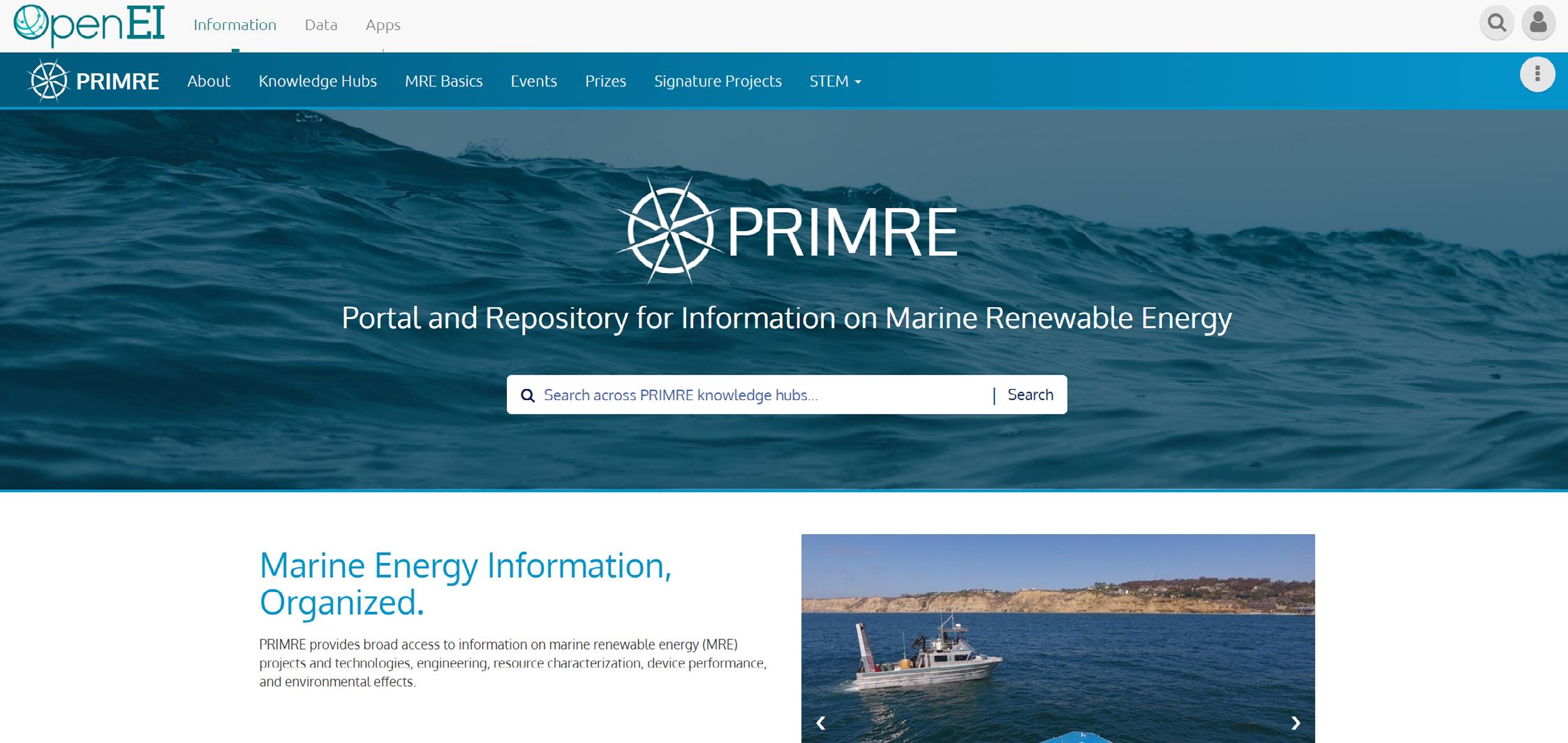
https://openei.org/wiki/PRIMRE
STEM - https://openei.org/wiki/PRIMRE/STEM
MRE Basics - https://openei.org/wiki/PRIMRE/MRE_Basics
Educator Resources - https://openei.org/wiki/PRIMRE/STEM/Resources/Educator_Resources
Renewable Energy Discovery Island (REDi) - https://openei.org/wiki/PRIMRE/REDi_Island
US. Department of Energy, Office of Energy Efficiency and Renewable Energy
Energy 101: Marine and Hydrokinetic Energy Video - https://www.energy.gov/eere/videos/energy-101-marine-and-hydrokineticenergy
U.S. Fish and Wildlife Service, Hydrokinetic Energy
https://www.fws.gov/node/265253
National Renewable Energy Laboratory, Marine Energy Research
https://www.nrel.gov/water/marine-energy.html
U.S. Department of the Interior, Bureau of Ocean Energy Management
https://www.boem.gov/renewable-energy
European Marine Energy Centre
http://www.emec.org.uk
4 Written explanations illustrate accurate and thorough understanding of scientific concepts.
The student independently conducts investigations and designs and carries out his or her own investigations.
3 Written explanations illustrate an accurate understanding of most scientific concepts.
2 Written explanations illustrate a limited understanding of scientific concepts.
The student follows procedures accurately to conduct given investigations, begins to design his or her own investigations.
The student may not conduct an investigation completely, parts of the inquiry process are missing.
Comprehensive data is collected and thorough observations are made. Diagrams, charts, tables, and graphs are used and labeled appropriately. Data and observations are presented clearly and neatly with appropriate labels.
Necessary data is collected. Observations are recorded. Diagrams, charts, tables, and graphs are used appropriately most of the time. Data is presented clearly, and neatly.
The student clearly communicates what was learned and uses strong evidence to support reasoning. The conclusion includes application to real life situations.
The student communicates what was learned and uses some evidence to support reasoning.
1 Written explanations illustrate an inaccurate understanding of scientific concepts.
The student needs significant support to conduct an investigation.
4 Project covers the topic in-depth with many details and examples. Subject knowledge is excellent.
3 Project includes essential information about the topic. Subject knowledge is good.
2 Project includes essential information about the topic, but there are 1-2 factual errors.
1 Project includes minimal information or there are several factual errors.
Some data is collected. The student may lean more heavily on observations. Diagrams, charts, tables, and graphs may be used inappropriately, have some missing information, or are labeled without 100% accuracy.
Data and/or observations are missing or inaccurate.
The student communicates what was learned but is missing evidence to support reasoning.
The conclusion is missing or inaccurate.
Content is very well organized and presented in a logical sequence.
Content is logically organized.
Content is logically organized with a few confusing sections.
There is no clear organizational structure, just a compilation of facts.
Project shows much original thought. Ideas are creative and inventive.
Project shows some original thought. Work shows new ideas and insights.
Project provides essential information, but there is little evidence of original thinking.
Project provides some essential information, but no original thought.
The workload is divided and shared equally by all members of the group.
The workload is divided and shared fairly equally by all group members, but workloads may vary.
The workload is divided, but one person in the group did not do his/her fair share of the work.
The workload is not divided, or several members are not doing their fair share of the work.
Duplicate as many MHK Bingo sheets (found on page 32 of the Teacher Guide) as needed for each person in your group. In addition, decide now if you want to give the winner of your game a prize and what the prize will be.
Pass out one MHK Bingo sheet to each member of the group.
Give the group the following instructions to create bingo cards:
This bingo activity is very similar to regular bingo. However, there are a few things you’ll need to know to play this game. First, please take a minute to look at your bingo sheet and read the 16 statements at the top of the page. Shortly, you’ll be going around the room trying to find 16 people about whom the statements are true so you can write their names in one of the 16 boxes.
When I give you the signal, you’ll get up and ask a person if a statement at the top of your bingo sheet is true for them. If the person gives what you believe is a correct response, write the person’s name in the corresponding box on the lower part of the page. For example, if you ask a person question “D” and they give you what you think is a correct response, then go ahead and write the person’s name in box D. A correct response is important because later on, if you get bingo, that person will be asked to answer the question correctly in front of the group. If they can’t answer the question correctly, then you lose bingo. So, if someone gives you an incorrect answer, ask someone else! Don’t use your name for one of the boxes or use the same person’s name twice.
Try to fill all 16 boxes in the next 20 minutes. This will increase your chances of winning. After the 20 minutes are up, please sit down and I will begin asking players to stand up and give their names. Are there any questions? You’ll now have 20 minutes. Go!
During the next 20 minutes, move around the room to assist the players. Every five minutes or so tell the players how many minutes are remaining in the game. Give the players a warning when just a minute or two remains. When the 20 minutes are up, stop the players and ask them to be seated.
Give the class the following instructions to play the game:
When I point to you, please stand up and in a LOUD and CLEAR voice give us your name. Now, if anyone has the name of the person I call on, put a big “X” in the box with that person’s name. When you get four names in a row—across, down, or diagonally—shout “Bingo!” Then I’ll ask you to come up front to verify your results.
Let’s start off with you (point to a player in the group). Please stand and give us your name. (Player gives name. Let’s say the player’s name was “Joe.”) Okay, players, if any of you have Joe’s name in one of your boxes, go ahead and put an “X” through that box.
When the first player shouts “Bingo,” ask them to come to the front of the room. Ask them to give their name. Then ask them to tell the group how their bingo run was made, e.g., down from A to M, across from E to H, and so on.
Bingo is a great icebreaker for a NEED workshop or conference. As a classroom activity, it also makes a great introduction to an energy unit.
5 minutes
45 minutes
Bingos are available on several different topics. Check out these resources for more bingo options!
Biomass Bingo—Energy Stories and More
Change a Light Bingo—Energy Conservation Contract
Coal Bingo—Coal guides
Energy Bingo—Energy Games and Icebreakers
Energy Efficiency Bingo— School Energy Experts and School Energy Managers
Hydrogen Bingo—H2 Educate
Hydropower Bingo — Hydropower guides
Nuclear Energy Bingo— Nuclear guides
Oil and Natural Gas Bingo— Oil and Natural Gas guides
Science of Energy Bingo— Science of Energy guides
Solar Bingo—Solar guides
Transportation Bingo— Transportation guides
Wind Energy Bingo—Wind Energy Guides
Now you need to verify the bingo winner’s results. Ask the bingo winner to call out the first person’s name on their bingo run. That player then stands and the bingo winner asks them the question which they previously answered during the 20-minute session. For example, if the statement was “can name two renewable sources of energy,” the player must now name two sources. If they can answer the question correctly, the bingo winner calls out the next person’s name on their bingo run. However, if they do not answer the question correctly, the bingo winner does not have bingo after all and must sit down with the rest of the players. You should continue to point to players until another person yells “Bingo.”
A. Knows the percentage of U.S. electricity supplied by hydropower B. Knows the unit used for distance on water and in the air
C. Can name the energy transformation involved with MHK devices
E. Can explain what a generator does F. Knows the name for the highest part of a wave G. Can name the device that captures the energy of moving water
I. Knows the source of energy that drives the water cycle
M. Can name the effect responsible for the curving of ocean and wind currents
J. Knows what energy source causes ocean waves K. Can explain the force that produces tides in the ocean
N. Knows the state that produces the most hydropower
O. Can name one challenge of siting a device in ocean water
D. Can name two types of marine or hydrokinetic energy
H. Can name the energy source that supplies most of U.S. electricity
L. Can name one factor or force responsible for ocean currents
P. Knows the name of the device that increases or decreases voltage for transportation or safe use
5-10% depending on amount of rainfall nautical mile motion to electrical
Coriolis Effect
wave, tidal, currents, OTEC, salinity gradient
generator converts kinetic energy into electrical energy crest a turbine captures the energy of moving water natural gas produces about 40% of U.S. electricity
solar energy drives the water cycle ocean waves are caused primarily by wind tides are mostly formed by the gravitational pull of the moon wind, salinity, temperature, density, gravity, or oceanfloor
Washington State corrosion (salt water), access, friction, etc. transformer
In the United States we use a variety of resources to meet our energy needs. Use the information below to analyze how each energy source is stored and delivered.
Using the graphic below, determine how energy is stored or delivered in each of the sources of energy. Remember, if the source of energy must be burned, the energy is stored as chemical energy.
NONRENEWABLE
Petroleum CHEMICAL Natural Gas CHEMICAL Coal CHEMICAL Uranium NUCLEAR Propane CHEMICAL
Biomass CHEMICAL Wind MOTION Hydropower MOTION Solar RADIANT Geothermal THERMAL
Look at the U.S. Energy Consumption by Source graphic below and calculate the percentage of the nation’s energy use that each form of energy provides.
What percentage of the nation’s energy is provided by each form of energy?
Chemical 83.49% Nuclear 8.89% Motion 6.03% Radiant 1.34% Thermal 0.23%
What percentage of the nation’s energy is provided by nonrenewables? 87.50% by renewables? 12.48%
PETROLEUM 34.73%
Uses: transportation, manufacturing - includes propane
NATURAL GAS 33.99%
Uses: heating, manufacturing, electricity - includes propane
COAL 9.89%
Uses: electricity, manufacturing
URANIUM 8.89% Uses: electricity
PROPANE
Uses: heating, manufacturing
BIOMASS 4.88% Uses: heating, electricity, transportation
WIND 3.24% Uses: electricity
HYDROPOWER 2.79% Uses: electricity
SOLAR 1.34% Uses: heating, electricity
*Propane consumption is included in petroleum and natural gas totals.
GEOTHERMAL 0.23% Uses: heating, electricity
**Total does not add up to 100% due to independent rounding. Data: Energy Information Administration
In 2020, biomass produced 56.1 billion kilowatt-hours of electricity, 1.40 percent of the nation’s total. Biomass electricity is usually the result of burning wood waste, landfill gas, and solid waste.
90 percent of the nation’s coal is consumed by electric utility companies to produce electricity. In 2020, coal produced 773.8 billion kilowatt-hours of electricity, which was 19.30 percent of the nation’s electricity.
In 2020, geothermal power plants produced 16.9 billion kilowatt-hours of electricity, mostly from facilities in the western U.S. Geothermal energy produced 0.42 percent of the nation’s electricity.
7.13 percent of U.S. electricity is generated by 2,500 hydro plants nationwide. Hydro plants produced 285.8 billion kilowatt-hours of electricityin 2020.
PETROLEUM
Natural gas produced 1,616.7 billion kilowatt-hours of electricity in 2020, generating 40.33 percent of the nation’s electricity. Natural gas is used by turbines to provide electricity during peak hours of demand.
Petroleum provided 0.44 percent of U.S. electricity, generating 17.5 billion kilowatt-hours of electric power in 2020.
There are no statistics available for propane’s contribution to electricity generation. Very little propane is used to produce electricity.
Solar energy provided about 2.27 percent of U.S. electricity in 2020, amounting to 90.9 billion kilowatt-hours of electricity. Electricity was generated by solar thermal systems or photovoltaic arrays.
URANIUM
WIND
94 nuclear reactors provided the nation with 19.7 percent of its electrical energy needs in 2020. Nuclear energy produced 789.9 billion kilowatt hours of electricity.
Wind energy produced 337.5 billion kilowatt-hours of electricity in 2020, providing 8.42 percent of the nation’s electricity. Most of the windgenerated electricity is produced in Texas, Iowa, and Oklahoma.
Error points are the absolute difference between your ranks and EIA’s (disregard plus or minus signs).
Data: Energy Information Administration, Annual Energy Report
ERROR POINTS TOTALS
SCORING:
0-12 Excellent 13-18 Good 19-24 Average
25-30 Fair 31-36 Poor 37-42 Very Poor
Multimeters are tools used to measure electricity. The multimeter allows you to measure current, resistance, and voltage, and displays the reading numerically.
When using a multimeter it should be noted that some measurements will never “stay still” at a single repeatable value. This is the nature of the variables being monitored in some circumstances. For example, if you were to measure the resistance between your two hands with the ohmmeter setting on the multimeter (megohm range—millions of ohms), you would find that the values would continuously change. How tightly you squeeze the metal probes and how “wet” or “dry” your skin might be can have a sizable effect on the reading that you obtain. In this situation you need a protocol or standardized method to allow you to record data. We recommend that you discuss with your class the variability of measurement and let them come up with a standard for collecting data. They may decide to go with the lowest reading, the highest reading, or the reading that appears most frequently in a certain time period.
1. Connect RED lead to VΩmA jack and BLACK to COM.
2. Set ROTARY SWITCH to the highest setting on the DC VOLTAGE scale (1000).
3. Connect leads to the device to be tested using the alligator clips provided.
4. Adjust ROTARY SWITCH to lower settings until a satisfactory reading is obtained.
5. With the water turbine, usually the 20 DCV setting provides the best reading.
DC CURRENT MUST INCLUDE A LOAD IN THE CIRCUIT - NOT NECESSARY FOR THESE ACTIVITIES
1. Connect RED lead to VΩmA jack and BLACK to COM.
2. Set ROTARY SWITCH to 10 ADC setting.
3. Connect leads to the device to be tested using the alligator clips provided.
Note: The reading indicates DC AMPS; a reading of 0.25 amps equals 250 ma (milliamps).
YOUR MULTIMETER MIGHT BE SLIGHTLY DIFFERENT FROM THE ONE SHOWN. BEFORE USING THE MULTIMETER, READ THE OPERATOR’S INSTRUCTION MANUAL INCLUDED IN THE BOX FOR SAFETY INFORMATION AND COMPLETE OPERATING INSTRUCTIONS.
Smaller
(m)illi = x 1/1000 or 0.001 or (µ) micro = x 1/1000000 or 0.000001 or 10 -6 (n)ano = x 1/100000000 or 0.000000001 or 10 -9 (p)ico = x 1/1000000000000 or 0.000000000001 or 10 -12 Bigger (k)ilo = x 1000 or 103 (M)ega = x 1000000 or 106 (G)iga = x 1000000000 or 109
The formula pie works for any three variable equation. Put your finger on the variable you want to solve for and the operation you need is revealed.
is additive)
RT = R1 + R2 + R3… + Rn
Parallel Resistance (Resistance is reciprocal)
1/RT = 1/R1 + 1/R2+ 1/R3… + 1/Rn
NOTE: ALWAYS convert the values you are working with to the BASE unit. For example, don’t plug kilohms (kΩ) into the equation—convert the value to ohms (Ω) first.
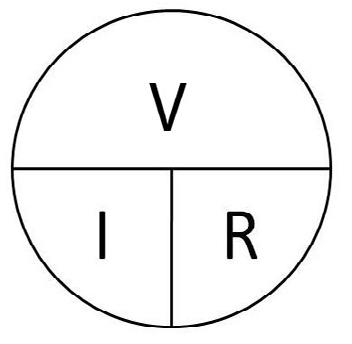
The magnets in the Model Wave Generator are very strong. In order to separate them, students should slide/ twist them apart. Please also take the following precautions:
Wear safety glasses when handling magnets.
Use caution when handling the magnets. Fingers can easily be pinched between the attracting magnets.
When you set the magnets down, place them far enough away from each other that the magnets won’t snap back together.
When you are finished with the magnets and ready to store them, put a small piece of cardboard between them.
Keep magnets away from your computer screen, cell phone, debit/credit cards, ID badges, and medical devices.
If the galvanometer does not display a reading, check the following:
1. Test the model with a multimeter.
2. Was the wire coating removed from the ends of the wire? Has the exposed wire oxidized?
3. Were the coils of wire wrapped tightly and in the correct number?
A. Knows the percentage of U.S. electricity supplied by hydropower
E. Can explain what a generator does
I. Knows the source of energy that drives the water cycle
M. Can name the effect responsible for the curving of ocean and wind currents
B. Knows the unit used for distance on water and in the air
F. Knows the name for the highest part of a wave
J. Knows what energy source causes ocean waves
N. Knows the state that produces the most hydropower
C. Can name the energy transformation involved with MHK devices
G. Can name the device that captures the energy of flowing water
K. Can explain the force that produces tides in the ocean
O. Can name one challenge of siting a device in ocean water
D. Can name two types of marine or hydrokinetic energy
H. Can name the energy source that supplies most of U.S. electricity
L. Can name one factor or force responsible for ocean currents
P. Knows the name of the device that increases or decreases voltage for transportation or safe use
http://need-media.smugmug.com/
On NEED’s SmugMug page, you’ll find pictures of NEED students learning and teaching about energy. Would you like to submit images or videos to NEED’s gallery? E-mail info@NEED.org for more information.
Also use SmugMug to find these visual resources:

Would you like to use NEED’s graphics in your own classroom presentations, or allow students to use them in their presentations? Download graphics for easy use in your classroom.

Looking for more resources? Our Awesome Extras page contains PowerPoints, animations, and other great resources to compliment what you are teaching in your classroom! This page is available under the Educators tab at www.NEED.org/educators/ awesome-extras/.
We feature new curriculum, teacher news, upcoming programs, and exciting resources regularly. To read the latest from the NEED network, visit www.NEED.org/about-need/news/.
Building an assessment? Searching for standards? Check out our Evaluations page for a question bank, NEED’s Energy Polls, sample rubrics, links to standards alignment, and more at www.NEED.org/educators/evaluations-assessment/.
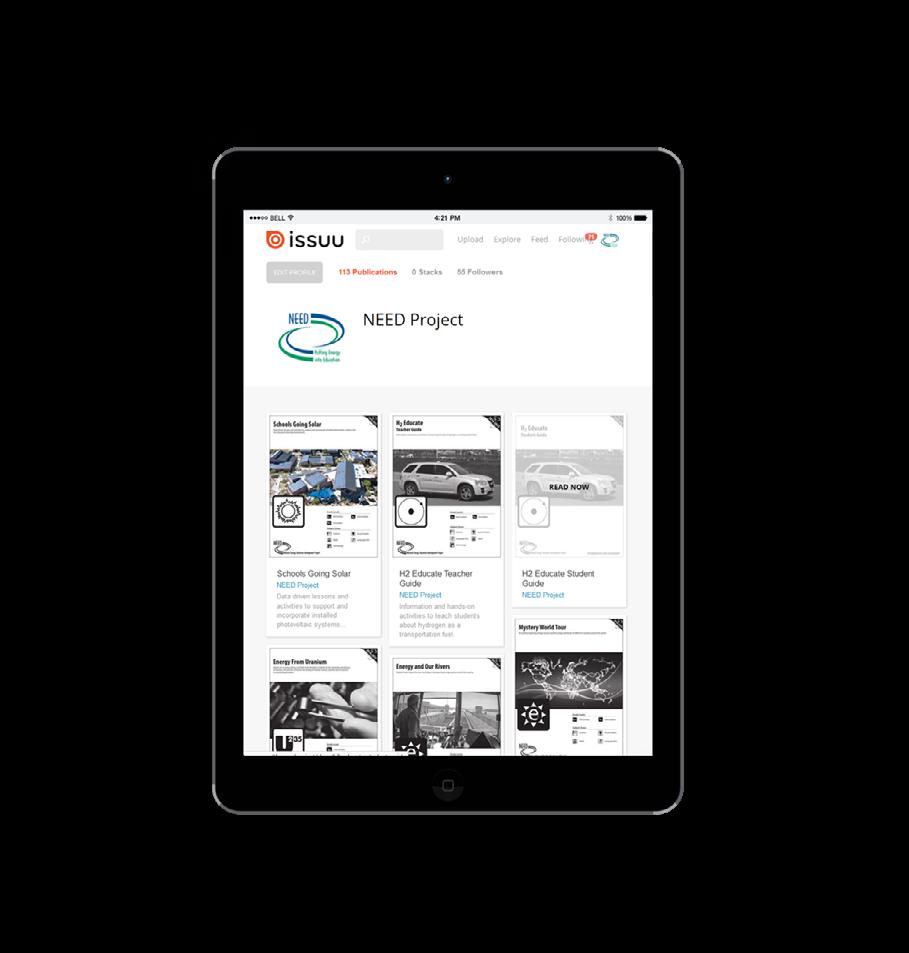
The NEED Project offers e-publication versions of various guides for in-classroom use. Guides that are currently available as an e-publication can be found at www.issuu.com/theneedproject.
Stay up-to-date with NEED. “Like” us on Facebook! Search for The NEED Project, and check out all we’ve got going on!




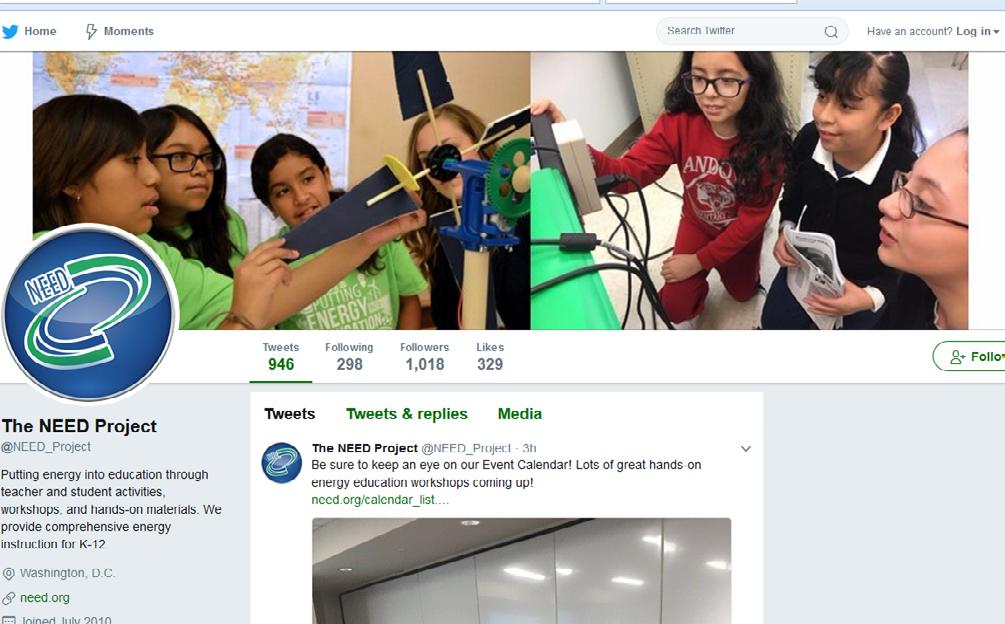
Follow us on Twitter. We share the latest energy news from around the country, @NEED_Project.

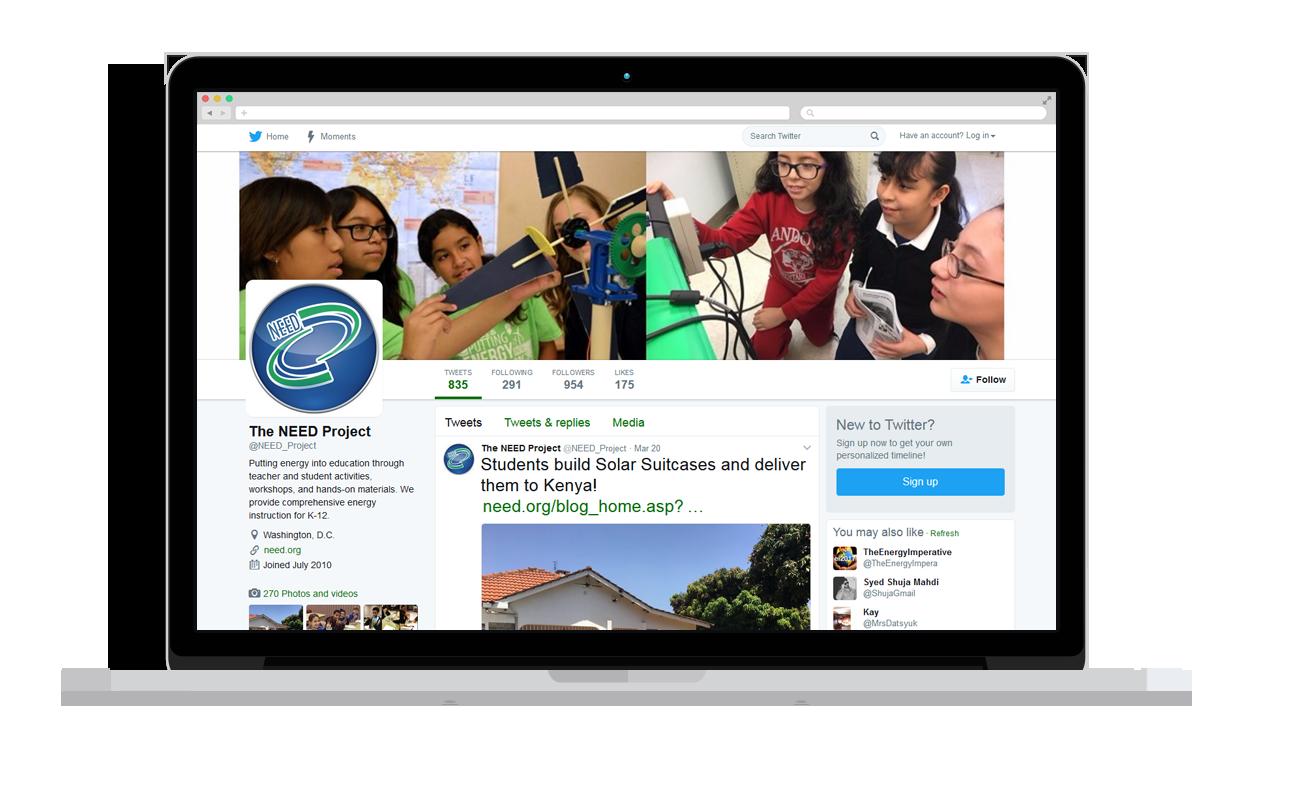
Follow us on Instagram and check out the photos taken at NEED events, instagram.com/theneedproject.
Follow us on Pinterest and pin ideas to use in your classroom, Pinterest.com/NeedProject.

Subscribe to our YouTube channel! www.youtube.com/user/NEEDproject
Looking for cross-curricular connections, or extra background reading for your students? NEED’s booklist provides an extensive list of fiction and nonfiction titles for all grade levels to support energy units in the science, social studies, or language arts setting. Check it out at www.NEED.org/booklist/
Maps are a great way for students to visualize the energy picture in the United States. This set of maps will support your energy discussion and multi-disciplinary energy activities. Go to www.need.org/resources/ energy-in-society/?PortfolioCats29 to see energy production, consumption, and reserves all over the country!
Anemometers and solar cells and light meters — oh my! Getting your guides and kits (or refills) has never been easier! Check out NEED’s official online store at shop.NEED.org.
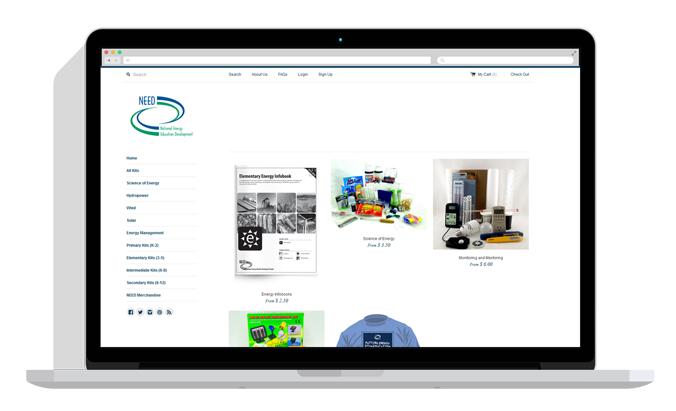
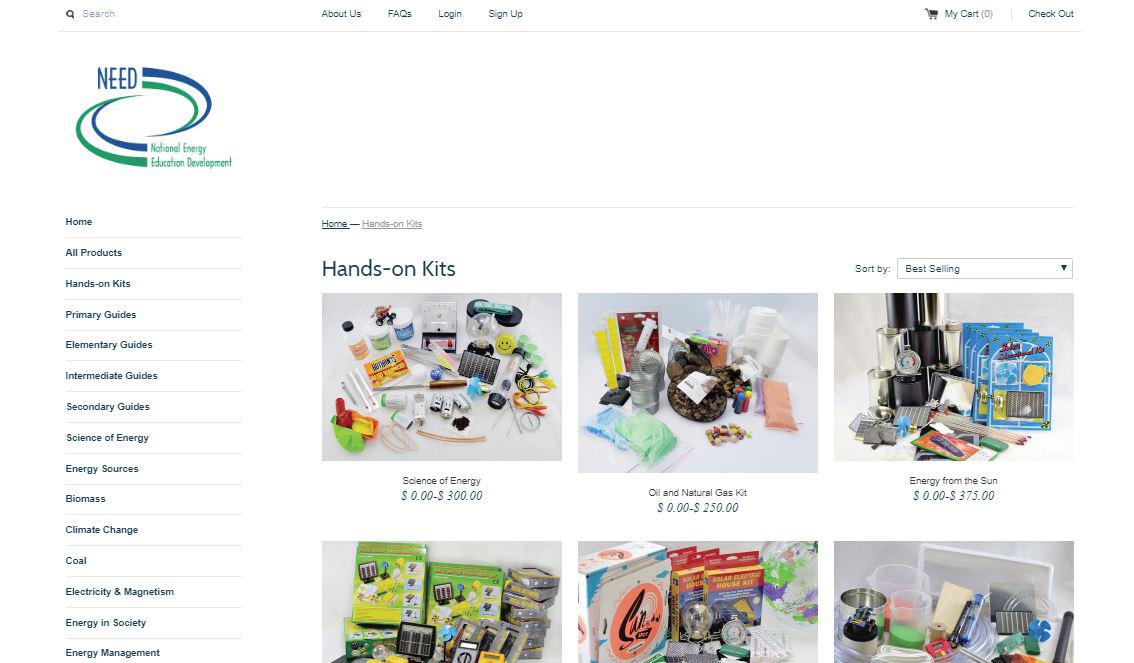
State: ___________ Grade Level: ___________ Number of Students: __________
1. Did you conduct the entire unit? Yes No 2. Were the instructions clear and easy to follow? Yes No 3. Did the activities meet your academic objectives? Yes No 4. Were the activities age appropriate? Yes No 5. Were the allotted times sufficient to conduct the activities? Yes No 6. Were the activities easy to use? Yes No 7. Was the preparation required acceptable for the activities? Yes No 8. Were the students interested and motivated? Yes No 9. Was the energy knowledge content age appropriate? Yes No
10. Would you teach this unit again? Yes No Please explain any ‘no’ statement below.
How would you rate the unit overall? excellent good fair poor
How would your students rate the unit overall? excellent good fair poor
What would make the unit more useful to you?
Other Comments:
Please fax or mail to: The NEED Project 8408 Kao Circle
FAX: 1-800-847-1820 Manassas, VA 20110 Email: info@need.org
AES AES Clean Energy Development
American Electric Power Foundation
Appalachian Voices
Arizona Sustainability Alliance
Baltimore Gas & Electric
Berkshire Gas - Avangrid BP America Inc.
Bob Moran Charitable Giving Fund
Cape Light Compact–Massachusetts Celanese Foundation
Central Alabama Electric Cooperative The City of Cuyahoga Falls
Clean Virginia CLEAResult
ComEd Con uence ConocoPhillips Constellation
Delmarva Power and Light
Department of Education and Early Childhood Development - Government of New Brunswick, Canada
Dominion Energy, Inc.
Dominion Energy Charitable Foundation DonorsChoose
East Baton Rouge Parish Schools
East Kentucky Power Cooperative EcoCentricNow
EDP Renewables
EduCon Educational Consulting Enel Green Power North America
ENGIE Entergy Eversource Exelon
Exelon Foundation Foundation for Environmental Education FPL
Generac
Georgia Power
Gerald Harrington, Geologist Government of Thailand–Energy Ministry
Greater New Orleans STEM
GREEN Charter Schools
Green Power EMC
Guilford County Schools–North Carolina Honeywell
Iowa Governor’s STEM Advisory CouncilScale Up
Iowa Lakes Community College
Iowa State University
Illinois Clean Energy Community Foundation
Illinois International Brotherhood of Electrical Workers Renewable Energy Fund
Independent Petroleum Association of New Mexico
Kansas Corporation Energy Commission
Kansas Energy Program – K-State Engineering Extension
Katy Independent School District
Kentucky O ce of Energy Policy
Kentucky Environmental Education Council
Kentucky Power–An AEP Company
Liberty Utilities
Llano Land and Exploration
Louisiana State Energy O ce
Louisiana State University – Agricultural Center
LUMA
Marshall University
Mercedes Benz USA
Minneapolis Public Schools
Mississippi Development Authority–Energy Division
Motus Experiential National Fuel National Grid
National Hydropower Association
National Ocean Industries Association National Renewable Energy Laboratory NC Green Power Nebraskans for Solar
NextEra Energy Resources
Nicor Gas
NCi – Northeast Construction
North Shore Gas
O shore Technology Conference
Ohio Energy Project
Oklahoma Gas and Electric Energy Corporation
Omaha Public Power District
Paci c Gas and Electric Company
PECO
Peoples Gas Pepco
Performance Services, Inc.
Permian Basin Petroleum Museum Phillips 66
PowerSouth Energy Cooperative
Prince George’s County O ce of Human Resource Management (MD)
Prince George’s County O ce of Sustainable Energy (MD)
Providence Public Schools
Quarto Publishing Group
The Rapha Foundation
Renewable Energy Alaska Project
Rhoades Energy
Rhode Island O ce of Energy Resources
Salal Foundation/Salal Credit Union
Salt River Project
Salt River Rural Electric Cooperative
Schneider Electric
C.T. Seaver Trust
Secure Futures, LLC
Shell Shell Carson SMUD
Society of Petroleum Engineers
South Carolina Energy O ce
Snohomish County PUD
SunTribe Solar
United Way of Greater Philadelphia and Southern New Jersey Unitil
University of Iowa University of Louisville University of North Carolina University of Northern Iowa University of Rhode Island
U.S. Department of Energy
U.S. Department of Energy–O ce of Energy E ciency and Renewable Energy
U.S. Department of Energy - Solar Decathlon
U.S. Department of Energy - Water Power Technologies O ce
U.S. Department of Energy–Wind for Schools
U.S. Energy Information Administration
United States Virgin Islands Energy O ce Virginia Cooperative Extension
We Care Solar
West Virginia O ce of Energy
West Warwick Public Schools